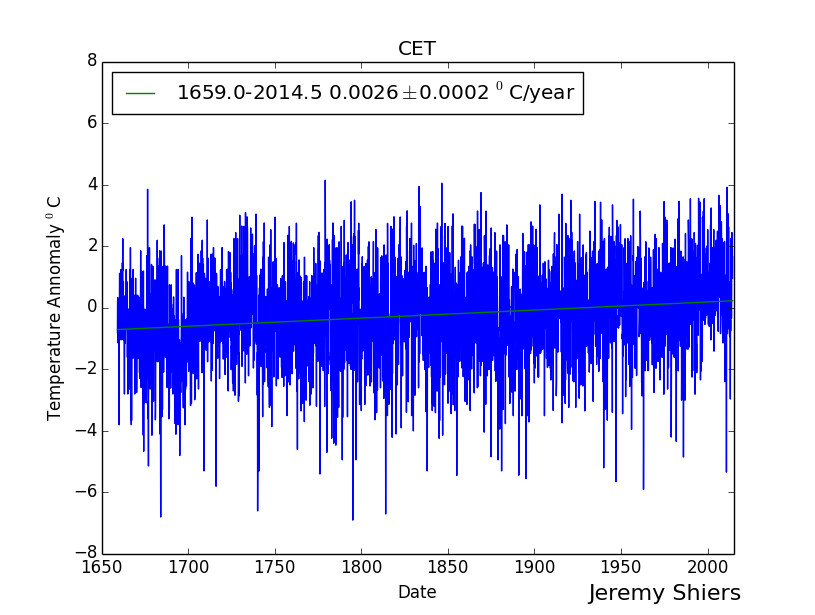Trying to get unbiased
data about the last 18 years - and longer
For a
layman it is not easy to get unbiased data. As we know, land surface
temperature (actually air temperature about two meters above the
surface) often is polluted by the heat island effect. Which means
growing cities, traffic and additional heat sources add temperature
which doesn't happen in the countryside.
We
have already the RSS satellite data, which shows the the air
temperature from 0 up to about 10,000 meters. It is referred as the
(only) graph with the longest zero trend in temperature rise. One
source alone seems to be not so much to get prove about a certain
matter. So I thought how to find other sources.
The
ocean has much (I think about 1000 times) more heat content as the
atmosphere and is more stable. And the temperature is actually
measured from the surface water, not from the air. Most of the ocean
water is in the southern half of the globe, and not so much
disturbance from industrial and from other human sources heated water
is there to be expected. So I choose the HADSHSST2 data to compare it
with the RSS.
http://woodfortrees.org/plot/hadsst2sh/from:1995/plot/hadsst2sh/from:1996.4/trend/plot/rss/from:1995/plot/rss/from:1996.6/trend
I was
somehow surprised to see the southern sea surface temperatures with
an about two months longer zero trend than the Satellite
measurements.
Okay,
they have stopped to give out now data for the HADSHSST2 for some
months, but you can see something very interesting: The sea surface
temperature is giving the lead in the zigzag game. And then the air
temperature follows, added with some additional heat from solar
radiation, creating higher bounces of the graph.
No I
was curious: are there other graphs that have similar lengths of zero
trend? And especially above land? And avoiding the heat island
effect? Maybe to measure the air a bit higher above the warming
cities? So I came to the RSS again, but now to the land-only graph.
http://woodfortrees.org/plot/hadsst2sh/from:1995/mean:13/plot/hadsst2sh/from:1996.4/trend/plot/rss/from:1995/mean:13/plot/rss/from:1996.6/trend/plot/rss-land/from:1995/mean:13/plot/rss-land/from:1996.6/trend
A 13
months running average was added to make the graphs more visible.
And
still the same zero trend, or even a bit longer for the air above
the land.
Some
more things are visible:
The
air temperature above land has much higher spikes as the global
satellite temperature, especially during the 1998 El-Nino.
When
sea and global temperatures are decreasing after a strong spike, The
land temperatures are steadily rising, even for some years (see 2001
to 2008).
Which
means:
global
temperature depends on the ocean temperature
land
surface is amplifying the temperature
with
using RSS you can get a somehow unbiased land temperature
The
southern oceans, bordering the antarctic continent, are not getting
hotter.
Just
being curious: What about the "improved" HADSHSST3 graph?
Important changes?
And
what about the northern sea surface temperatures compared to the
others?
Just
lets check:
http://woodfortrees.org/plot/hadsst2sh/from:1995/mean:13/plot/hadsst2sh/from:1996.4/trend/plot/hadsst3sh/from:1995/mean:13/plot/hadsst3sh/from:1996.6/trend/plot/hadsst2nh/from:1995/mean:13/plot/hadsst2nh/from:1996.6/trend
So
we see: Carefully selected data have given the HADSHSST3 some
"boost".
And
the northern Sea actually seems to be warming a bit quicker. Ocean
cycles? Biased data? The land mass of the northern hemisphere
influencing the ocean?
And
now a small guess: If we want to look back into former times, the
HADSHSST2 could be a somehow unbiased graph for this purpose.
http://woodfortrees.org/plot/hadsst2sh/from:1978/mean:13/plot/hadsst2sh/from:1978/trend/plot/rss/mean:13/plot/rss/trend/plot/hadsst2gl/from:1978/mean:13/plot/hadsst2gl/from:1978/trend
It
didn't work as expected. The southern ocean temperature rise during
the complete satellite data from 1997 on was even lower. But global
ocean temperature HADSST2 fitted nicely.
Which
shows us also, that the recent warmer northern ocean was possibly due
to an ocean cycle.
Just
if my guess is right and the ocean temperature has the same way or
trend than the RSS and can be compared, how has it been during the
last 150 years or so?
http://woodfortrees.org/plot/hadsst2sh/mean:60/plot/hadsst2sh/trend/plot/hadsst2gl/mean:60/plot/hadsst2gl/trend
A
five year running mean is added for easier viewing.
The
total difference for HADSST Global and Southern hemisphere ocean
trend is 0.05 °C in 165 Years. Could be worse.
The trend of
global warming for this time span is 0.7 °C. Per decade this is
about 0.04 °C.
Could also be
worse. To reach the 2 °C goal we need centuries...
